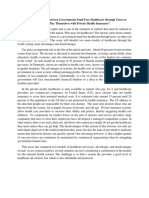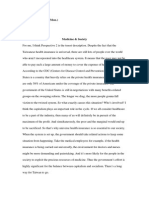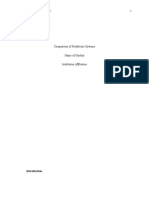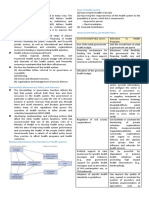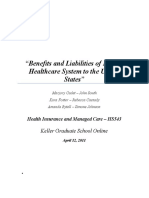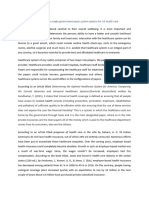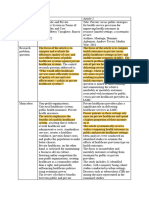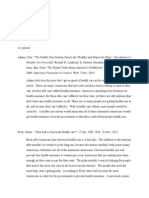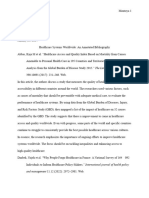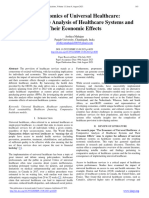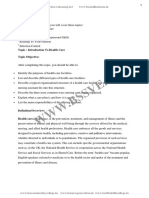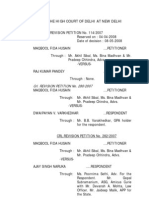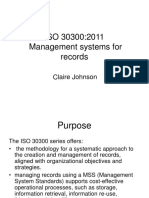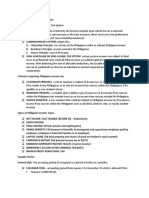1
Econ 149; US Healthcare System vs. UK Healthcare System
Name of Student
Institutional Affiliation
Course
Professor
Date
� 2
Healthcare is an important aspect of human existence since it ensures our safety and well-
being. Most authorities have invested in these sectors to ensure the sovereignty of the people in
protecting their rights. Access to medication is one of the core needs of human existence
(Bhattacharya et al. 2014). Although healthcare has the same obligation of offering ultimate
healthcare services, different states have different healthcare systems (Marjoua, & Bozic, 2012).
The two main healthcare system is the NHS system and the private health care system. The tax
people fund the NHS system are paying to the government. In contrast, the private system is
funded by the individual people through healthcare covers, and it is more projected in profit-
making inclination (Grosios et al. 2010). This essay will explore the comparison existing
between the UK NHS healthcare system and the US private healthcare system and analyze the
moral hazards existing in both systems.
The big difference existing between the two healthcare systems is in terms of private and
public sectors. In the United States, most healthcare systems are provided by the private sector.
Profit-making companies or charitable organizations either own the hospitals. Almost 84% of the
American population access health care from private providers, with most of them owning
private health insurance, Medicaid programs, and Medicare (Bhattacharya et al. 2014). The
remaining 16% depending on the public health care system due to their economic status and
failure to secure medical insurance from private healthcare providers. On the contrary United
Kingdom healthcare system is provided by public healthcare providers. The largest population is
dependent on the public sector as opposed to private sectors. The government has heavily
invested in public sectors by raising their expenditures to 8.4% of the GDP (Grosios et al. 2010).
I expect the UK healthcare system to achieve greater social equity since it offers public
healthcare system and is controlled by the government. The advantage is that the UK healthcare
� 3
system caters to all people irrespective of occupation, gender, race, religion, and other
demographic factors. The fact that 8.4% expenditure of the GDP has been projected to healthcare
services makes it appealing to society (Grosios et al. 2010). At least the tax that the people are
paying offers healthcare cover. The US is segregated, and the only people benefiting from
healthcare are the people above the poverty threshold and employed (Marjoua & Bozic, 2012).
For instance, the US employer-sponsored health insurance system gives secure coverage to the
employed people while the rest of the population struggle to meet healthcare service in private
healthcare providers.
The moral hazard in the UK healthcare system is high compared to that of the US
healthcare system. The fact that the healthcare system is being funded by the government and
8.4% of the expenditures of GDP is channeled to healthcare does not meet the quality healthcare
for all populations (Grosios et al. 2010). Although the UK ensures that all the people access
medical cover, the extensive approach leads to a low-quality healthcare system. The NHS fund
generated from the tax is worrying about sustaining the provisions of healthcare (Einav, &
Finkelstein, 2018). On the contrary, the US has many moral hazards, especially with the
employer-sponsored health insurance system that ensures that the quality of care meets consumer
demands. Private base healthcare providers are profit makers, and the way they are benefiting
from the working class does worry their insurance covers (Marjoua, & Bozic, 2012). However,
this is a disadvantage to the unemployed people since for proper care; the private sectors provide
cover that will ensure profit.
Both the US and UK have formulated different strategies to safeguard against moral
hazards. The NHS deals with the moral hazard by rationing the healthcare, thus saving on the
risk that might be involved in overstretching the available healthcare services (Grosios et al.
� 4
2010). For instance, the NHS may rationalize by limiting the individual choices in accessing
medical care. In addition, introducing a waiting list to limit the services provided to the people.
Gatekeeping can also be a strategy to control individual access to healthcare services. In private
healthcare, such as that in the UK, the moral hazard can be controlled by limiting the insurance
policy to the individual (Marjoua, & Bozic, 2012). For instance, if the employer-sponsored
health insurance system covers some healthcare services, it can be limited to some of the
services.
A young entrepreneur will prefer the US healthcare system since he/she will be
privileged to enjoy most medical insurance covers. According to the survey report by WHO, the
US ranks among the top in healthcare responsiveness to ye needs and the wants of the people.
Therefore in cases of emergencies, the entrepreneur can access quality healthcare within a short
period. In addition, the US healthcare system offers customers a variety of healthcare coverage
plans to choose from, thus allowing them to select the plan that aligns with their economic status.
In this regard, I think young entrepreneurs will prefer the US healthcare system to the UK
healthcare system.
In conclusion, the provision of healthcare is vital to the people since it protects their
rights. Although the healthcare system should ensure quality healthcare provision to the people,
the differences in healthcare systems shape the quality of healthcare in a particular state. The
NHS system caters to all the people, while the private system caters to insured people. In
addition, the moral hazards affect both systems at different extents due to the economic
inclination. US depicts a good example of the private healthcare system while UK depicts a good
example of the NHS system, as discussed in the essay. The two have a great difference, as
discussed.
� 5
References
Bhattacharya, J., Hyde, T., & Tu, P. (2014). Health economics / Jay Bhattacharya, Timothy
Hyde, Peter Tu. Palgrave Macmillan
Einav, L., & Finkelstein, A. (2018). Moral hazard in health insurance: What we know and how
we know it. Journal of the European Economic Association, 16(4), 957-982.
Grosios, K., Gahan, P. B., & Burbidge, J. (2010). Overview of healthcare in the UK. EPMA
Journal, 1(4), 529-534.
Marjoua, Y., & Bozic, K. J. (2012). Brief history of quality movement in US healthcare. Current
reviews in musculoskeletal medicine, 5(4), 265-273.




